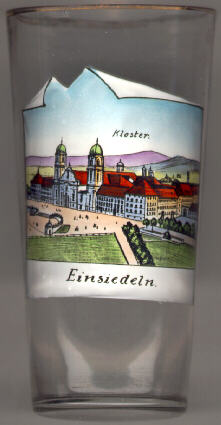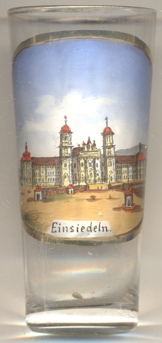

|
| SCHWEIZ / SUISSE / SVIZZERA / SVIZRA | SWITZERLAND |
| Schwyz / Schwytz / Svitto / Sviz |
 Saint Meinrad (b. around 800, d. 861),
a Benedictine monk from the island Reichenau in Lake Constance
and descendant of the family of the Counts of Hohenzollern, came into the area which today is known as
Einsiedeln in AD 835 to live here as a hermit (Einsiedler = German for hermit).
He was followed by others, and in 934 Eberhard, previously Provost of Strasbourg,
founded a Benedictine monastery of which he became the first abbot. There is a legend that the
church was miraculously consecrated in 948 by Christ Himself, assisted by the four Evangelists, St. Peter,
and St. Gregory the Great. Perhaps the most important member of the monastery
was St. Wolfgang (d. 994), later bishop of Regensburg
(see also Sankt Wolfgang im Salzkammergut).
The third abbot of Einsiedeln, Gregor, was styled prince abbot by Emperor Otto I,
and the successors enjoyed the same dignity. Einsiedeln was made an independent
principality by king Rudolf I in 1274. Although the monastery suffered a serious decline
during the Reformation, the pilgrimages to the church of Our Lady flourished
again during the following centuries. The monastery remained independent until the French Revolution.
In 1897 it was dissolved and the monks went into exile which, however, lasted for 3 years only.
Today the monastery enjoys the status nullius dioecesis which means that the abbot
has quasi-episcopal rights.
Saint Meinrad (b. around 800, d. 861),
a Benedictine monk from the island Reichenau in Lake Constance
and descendant of the family of the Counts of Hohenzollern, came into the area which today is known as
Einsiedeln in AD 835 to live here as a hermit (Einsiedler = German for hermit).
He was followed by others, and in 934 Eberhard, previously Provost of Strasbourg,
founded a Benedictine monastery of which he became the first abbot. There is a legend that the
church was miraculously consecrated in 948 by Christ Himself, assisted by the four Evangelists, St. Peter,
and St. Gregory the Great. Perhaps the most important member of the monastery
was St. Wolfgang (d. 994), later bishop of Regensburg
(see also Sankt Wolfgang im Salzkammergut).
The third abbot of Einsiedeln, Gregor, was styled prince abbot by Emperor Otto I,
and the successors enjoyed the same dignity. Einsiedeln was made an independent
principality by king Rudolf I in 1274. Although the monastery suffered a serious decline
during the Reformation, the pilgrimages to the church of Our Lady flourished
again during the following centuries. The monastery remained independent until the French Revolution.
In 1897 it was dissolved and the monks went into exile which, however, lasted for 3 years only.
Today the monastery enjoys the status nullius dioecesis which means that the abbot
has quasi-episcopal rights.

As the Romanesque and Gothic building of the monastery had suffered during
the course of the centuries, a new monastery
was started to be built in 1704. The central building is, of course, the
 monastery
monastery
The library of the monastery which dates back to AD 946 contains over 15,000 volumes and priceless manuscripts.

![[scale]](lineal.jpg)